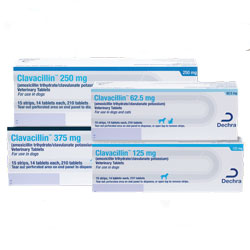Clavacillin Veterinary Tablets
+ Save on each recurring order!
Free Shipping on orders over $75
Low Price Match Guarantee
- Skin and soft tissue infections in dogs and cats
- Available Sizes (1 count & 210 count):
- 62.5mg
- 125mg
- 250mg
- 375mg
Description
Clavacillin™ Veterinary Tablets (amoxicillin trihydrate/clavulanate potassium) is an orally
administered formulation comprised of the broad-spectrum antibiotic
amoxicillin trihydrate and the β-lactamase inhibitor, clavulanate potassium.
Indications
Dogs
Indicated in the treatment of periodontal and skin and soft tissue infections such as wounds, abscesses, cellulitis, and superficial/juvenile and deep pyoderma due to susceptible strains of bacteria.
Cats
Indicated in the treatment of urinary tract infections
(cystitis) and skin and soft tissue infections such as
wounds, abscesses, and cellulitis/dermatitis due to
susceptible strains of bacteria.
What's in Clavacillin™ Veterinary Tablets?
Amoxicillin trihydrate is a semisynthetic antibiotic with a broad spectrum
of bactericidal activity against many gram-positive and gram-negative,
aerobic and anaerobic microorganisms. It does not resist destruction by
β-lactamases; therefore, it is not effective against β-lactamase-producing
bacteria. Chemically, it is D(-)-α-amino-p-hydroxybenzyl penicillin
trihydrate.
Clavulanic acid, an inhibitor of β-lactamase enzymes, is produced by the
fermentation of Streptomyces clavuligerus. Clavulanic acid by itself has
only weak antibacterial activity. Chemically, clavulanate potassium is
potassium z-(3R,5R)-2-β-hydroxyethylidene clavam-3-carboxylate
Dosage and Administration
Dogs
The recommended dosage is 6.25 mg/lb of body weight twice a day. Skin and soft tissue infections such as abscesses, cellulitis, wounds, superficial/juvenile pyoderma, and periodontal infections should be treated for 5-7 days or for 48 hours after all symptoms have subsided. If no response is seen after 5 days of treatment, therapy should be discontinued and the case reevaluated. Deep pyoderma may require treatment for 21 days; the maximum duration of treatment should not exceed 30 days.Cats
The recommended dosage is 62.5 mg twice a day. Skin and soft tissue infections such as abscesses and cellulitis/dermatitis should be treated for 5-7 days or for 48 hours after all symptoms have subsided, not to exceed 30 days. If no response is seen after 3 days of treatment, therapy should be discontinued and the case reevaluated. Urinary tract infections may require treatment for 10-14 days or longer. The maximum duration of treatment should not exceed 30 days. See label for complete details.Ingredients
| Clavacillin Trihydrate and Clavulanate Potassium 62.5 mg Tablet |
|
| Active Ingredient | Amount |
| Amoxicillin Trihydrate equivalent of amoxicillin activity | 50 mg |
| Clavulanic Acid as the potassium salt | 12.5 mg |
| Clavacillin Trihydrate and Clavulanate Potassium 125 mg Tablet | |
| Active Ingredient | Amount |
| Amoxicillin Trihydrate equivalent of amoxicillin activity | 100 mg |
| Clavulanic Acid as the potassium salt | 25 mg |
| Clavacillin Trihydrate and Clavulanate Potassium 250 mg Tablet | |
| Active Ingredient | Amount |
| Amoxicillin Trihydrate equivalent of amoxicillin activity | 200 mg |
| Clavulanic Acid as the potassium salt | 50 mg |
| Clavacillin Trihydrate and Clavulanate Potassium 375 mg Tablet | |
| Active Ingredient | Amount |
| Amoxicillin Trihydrate equivalent of amoxicillin activity | 300 mg |
| Clavulanic Acid as the potassium salt | 75 mg |
Directions
View Clavacillin product label.
Dogs
The recommended dosage is 6.25 mg/lb of body weight twice a day.Skin and soft tissue infections such as abscesses, cellulitis, wounds, superficial/juvenile pyoderma, and periodontal infections should be treated for 5-7 days or for 48 hours after all symptoms have subsided. If no response is seen after 5 days of treatment, therapy should be discontinued and the case reevaluated. Deep pyoderma may require treatment for 21 days; the maximum duration of treatment should not exceed 30 days.
Cats
The recommended dosage is 62.5 mg twice a day.Skin and soft tissue infections such as abscesses and cellulitis/dermatitis should be treated for 5-7 days or for 48 hours after all symptoms have subsided, not to exceed 30 days. If no response is seen after 3 days of treatment, therapy should be discontinued and the case reevaluated.Urinary tract infections may require treatment for 10-14 days or longer. The maximum duration of treatment should not exceed 30 days.
Caution
Federal (USA) law restricts this drug to use by or on the order of a licensed veterinarian.
Actions
Clavacillin is stable in the presence of gastric acid and is not significantly influenced by gastric or intestinal contents. The 2 components are rapidly absorbed resulting in amoxicillin and clavulanic acid concentrations in serum, urine, and tissues similar to those produced when each is administered alone.
Amoxicillin and clavulanic acid diffuse readily into most body tissues and fluids with the exception of brain and spinal fluid, which amoxicillin penetrates adequately when meninges are inflamed. Most of the amoxicillin is excreted unchanged in the urine. Clavulanic acid's penetration into spinal fluid is unknown at this time. Approximately 15% of the administered dose of clavulanic acid is excreted in the urine within the first 6 hours.
Clavacillin combines the distinctive properties of a broad-spectrum antibiotic and a ß-lactamase inhibitor to effectively extend the antibacterial spectrum of amoxicillin to include ß-lactamase-producing as well as non-ß-lactamase-producing aerobic and anaerobic organisms.
Microbiology
Amoxicillin is bactericidal in action and acts through the inhibition of biosynthesis of cell wall mucopeptide of susceptible organisms. The action of clavulanic acid extends the antimicrobial spectrum of amoxicillin to include organisms resistant to amoxicillin and other ß-lactam antibiotics. Amoxicillin/clavulanate has been shown to have a wide range of activity which includes ß-lactamase-producing strains of both gram-positive and gram-negative aerobes, facultative anaerobes, and obligate anaerobes. Many strains of the following organisms, including ß-lactamase-producing strains, isolated from veterinary sources, were found to be susceptible to amoxicillin/clavulanate in vitro but the clinical significance of this activity has not been demonstrated for some of these organisms in animals.Aerobic bacteria, including Staphylococcus aureus1, ß-lactamase-producing Staphylococcus aureus1 (penicillin resistant), Staphylococcus species1, Staphylococcus epidermidis, Staphylococcus intermedius, Streptococcus faecalis, Streptococcus species1, Corynebacterium pyogenes, Corynebacterium species, Erysipelothrix rhusiopathiae, Bordetella bronchiseptica, Escherichia coli1, Proteus mirabilis, Proteus species, Enterobacter species, Klebsiella pneumoniae, Salmonella dublin, Salmonella typhimurium, Pasteurella multocida, Pasteurella haemolytica, Pasteurella species1.
1.The susceptibility of these organisms has also been demonstrated in in vivo studies.Studies have demonstrated that both aerobic and anaerobic flora are isolated from gingival cultures of dogs with clinical evidence of periodontal disease. Both gram-positive and gram-negative aerobic and anaerobic subgingival isolates indicate sensitivity to amoxicillin/clavulanic acid during antimicrobial susceptibility testing.
Contraindications
The use of this drug is contraindicated in animals with a history of an allergic reaction to any of the penicillins or cephalosporins.
Warnings
Safety of use in pregnant or breeding animals has not been determined. Store at controlled room temperature, 68-77°F (20-25°C). Do not remove from foil strip until ready to use.






